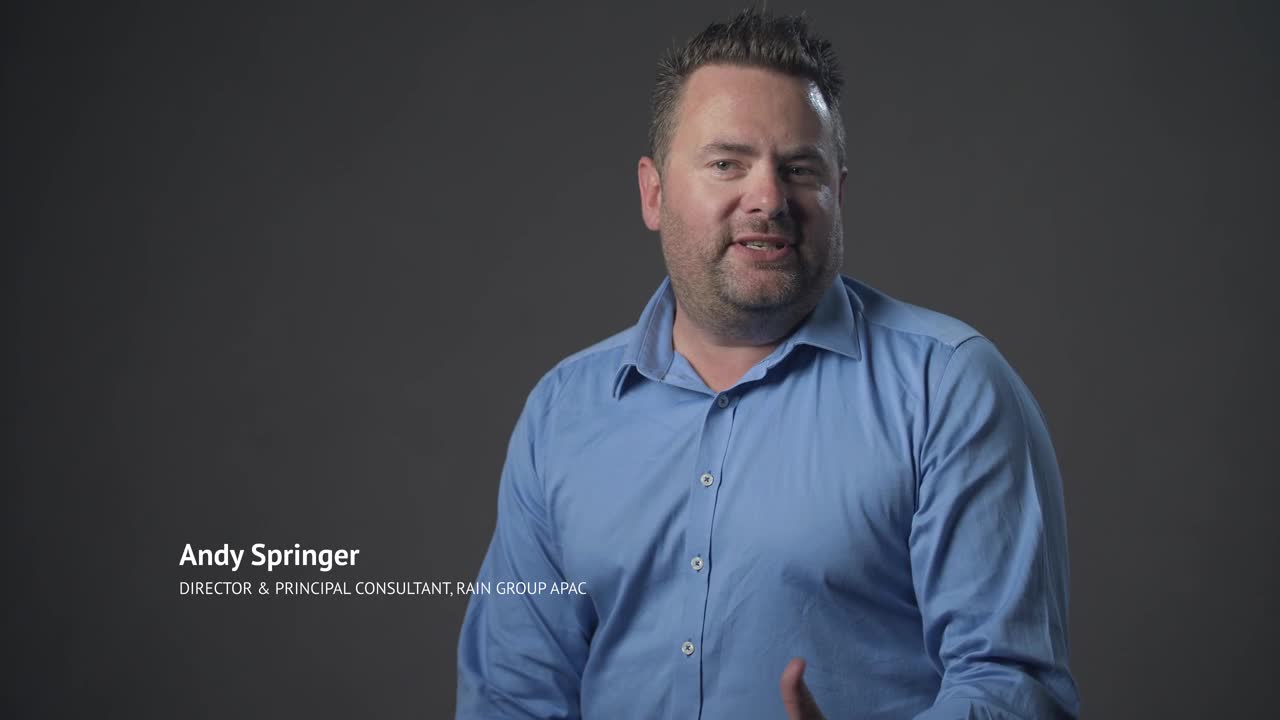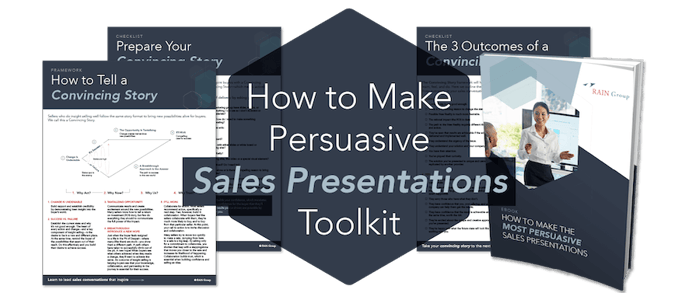Sellers who win consistently plan to win from the start. They're methodical in their approach to opportunities. They carefully map their sales process to the buyer's, set goals for every meeting, and do an exceptional job of communicating value.
Moreover, top sellers build strategies to proactively drive sales opportunities. The sales opportunity plan we use at RAIN Group is made up of six core elements we’ve refined over years of use. In this article, I’ll share each of the six elements in detail.
6 Elements of a Sales Opportunity Plan
What Is a Sales Opportunity Plan?
How Sales Opportunity Planning Contributes to Win Rate
In this video, Andy Springer shares an overview of the components of a buyer-centered sales opportunity planning approach.

What Is a Sales Opportunity Plan?
The idea behind sales opportunity planning is to accomplish four tasks: create and communicate maximum value for the buyer; leverage your resources; satisfy buying criteria; and edge out the competition. A thorough sales opportunity plan will accomplish these tasks by answering the following questions:
- What are the key elements of the specific value case for why this particular buyer should buy from you?
- What is your strategy to out-maneuver the competition?
- Who are the various buyers on the buying team and how might their buying criteria differ from person to person?
- What are the action steps first, next, and throughout the process?
- How much effort should you devote to one opportunity versus another?
How Sales Opportunity Planning Contributes to Win Rate
The primary goal of sales opportunity planning is to improve the likelihood of winning the deal.
Successful plans are built and aligned around creating and communicating value for the buyer. Everyone claims their company is buyer-focused. But consider the following statistics from our Top-Performing Sales Organization study:
- 35% of respondents didn't agree that their sales organization focuses on driving maximum value for the customer
- 52% of respondents didn't agree that their sales process was customer-focused
It's tough to have a buyer-focused sales organization when the planning tools and prompts are all about the seller and their goals.
For example, many opportunity plans contain prompts for capturing the seller’s mission, sales objectives, and sales positioning. What about the buyer’s mission? A case for buyer value? Buyer objectives and possible solutions?
6 Elements of Value-Centered Sales Opportunity Plans
Writing your plan is like crafting a business plan. It’s iterative. Nonlinear. You move back-and-forth between sections. You edit, adjust, and refine your thinking based on research, meetings, and discussions.
It’s the same for opportunities large and small. You still cover the same elements, you just move more quickly through the process depending on deal size. Maybe you selectively work on areas that you believe are essential for a given opportunity.
As to what your plan should include, here are the six elements of an effective, value-centered sales opportunity plan.
-
1. Opportunity Snapshot
In this foundational part of your plan, communicate the big-picture importance and status of the opportunity. Attend to the practical details, namely:
- Account name
- Opportunity name
- Demand dynamic
- Target revenue for the sale
- Target win date
- Win confidence
Also, determine whether you're pursuing the right opportunities and applying the correct pursuit intensity. Ask questions like:
- What's the desired outcome of this opportunity?
- What am I selling and for how much?
- When do I expect it to close?
- What obstacles am I facing?
- What strategies do I have for moving the sale forward?
- Is this sale qualified?
- What stage is this deal in?
-
2. People
To close high-value opportunities, you need to know the people on both your team and the buyer’s. For your team, keep track of everyone who'll be involved. Think beyond who's on your permanent selling team. Who could join meetings or be a part of a particular opportunity?
Let’s say the buyer is in the healthcare space. Is there anyone on your team who's closed healthcare deals? Those people are more likely to contribute innovative ideas during meetings or tap into personal insight to find potential value for the buyer.
With respect to the buyer’s team, know everybody’s roles in the decision-making process. Which buyer persona do they represent? What about buying modes? How strong are your relationships with each person on the team? Uncover and keep track of anyone who may have a say in the purchase decision. Analyze the buyer decision roles they play in decision making, which are:
- Approvers
- Business Drivers
- Champions
- Dominos
- Evaluators
-
3. Needs
Selling is about change. It’s about persuading buyers you can get them from a bad place to the promised land. To accurately juxtapose the buyer's current reality with the possible new reality, you need a thorough understanding of the buyer’s needs. These break down into two primary categories:
- Rational needs: Explicit rational needs, usually financial, technical, or strategic. There are also hidden or suspected needs that the buyer may have, but hasn't yet disclosed.
- Emotional needs: While these can also be explicit or just suspected, emotional needs are typically professional, social, or psychological—and they can be just as powerful as rational ones.
A common complaint sales leaders have is that their sellers don’t complete a thorough needs discovery. One of the merits of sales opportunity planning is that it prompts sellers to be thorough. In my experience, when sellers plan to be thorough, they are.
-
4. Opportunity Goal and Value Case
Now we get to what products and services comprise the overall solution. Start by listing the relevant components of your offering. Then, link each component to the value it provides the buyer. These points will eventually form your value messaging.
Note that we only do this after we have a strong idea of the buyer’s needs. Leading with a product or solution is a recipe for failure. Because buyers—especially buyers who aren’t yet solution aware—are unlikely to buy unless they can answer four questions about your value proposition:
- Why act? Buyer can articulate why your proposed solution is important.
- Why now? Buyer can articulate why your proposed solution is urgent.
- Why us? Buyer can articulate why your solution is the best choice.
- Why trust? Buyer can articulate why they should believe in your offering, company, and you.
If you want the buyer to answer these in a certain way, it’s immensely helpful to articulate the answers to yourself—ideally as part of your sales opportunity plan. To make the case as strong as possible, understand the true difference your solution will make for the buyer.
-
5. Competitors: Strengths, Weaknesses, and Vulnerabilities
This part of the sales opportunity plan is fairly straightforward. Compare your solution with alternatives based on the buyer’s stated decision-making criteria. What does the buyer value that you offer, but your competitors don't?
-
6. Advancing the Sale
Next, create the action plan to move the sale forward.
- Summarize your overall current position, with both strengths and vulnerabilities.
- Outline a response strategy for possible objections and roadblocks.
-
Create a big play. Some opportunities warrant what we call big plays. These are bold, atypical actions you can take to inspire buyer action and set themselves apart from the competition. In my experience, successful big plays require some creativity and courage.
For inspiration, read How to Win Big Sales Opportunities with Big Plays.
- Identify insights. Sales winners are much more likely than the rest to bring ideas to the table for buyers that are new, noteworthy, and non-intuitive. If you plan to bring ideas to the table, you’re much more likely to actually do it than if you leave it to chance.
- Map to the buying process. Top sellers think "buying first, selling second." They know the buyer's process and they leverage it. They match key steps in the buying process to their own sales process and strategize accordingly. Know the buying process and you can plan selling actions to succeed with it.
- Note critical comments and questions left to answer. Make notes to yourself that might influence the direction of the sale. Scour what you already have to bring together the most critical notes and questions in one place for future reference during this home stretch.
- Plan next steps. Record the action steps you need to take now, next, and throughout the rest of the process to win the sale.
Ask Yourself: What If I Dropped It on the Floor?
Let’s say you drop your completed sales opportunity plan on the floor of a buyer’s office and they stumbled across it. It’s our belief that the buyer should be more inclined to buy from you after reading it than if they hadn’t.
Done correctly, your sales opportunity plan will be all about them—their goals and needs, as well as how your offering creates value for them. They’ll see the thoughtfulness and thoroughness with which you’ve considered them as a buyer.
Too many sales opportunity plans show how a seller will achieve the seller’s goal by using tactics to “close a buyer” at “a high price, unless they push back,” and so on. It’s all seller-focused. Generic. When planning frameworks are too seller-focused, the behaviors and thinking becomes seller-focused, and that’s not good for creating strong relationships, driving maximum value, or winning.
To win sales opportunities, the focus should always be on the buyer.
You've found your buyer's needs—now convince them to move forward. In our How to Make Persuasive Sales Presentations Toolkit, we share resources and frameworks for leading impactful conversations at any stage of the sales cycle. Download now. >>







